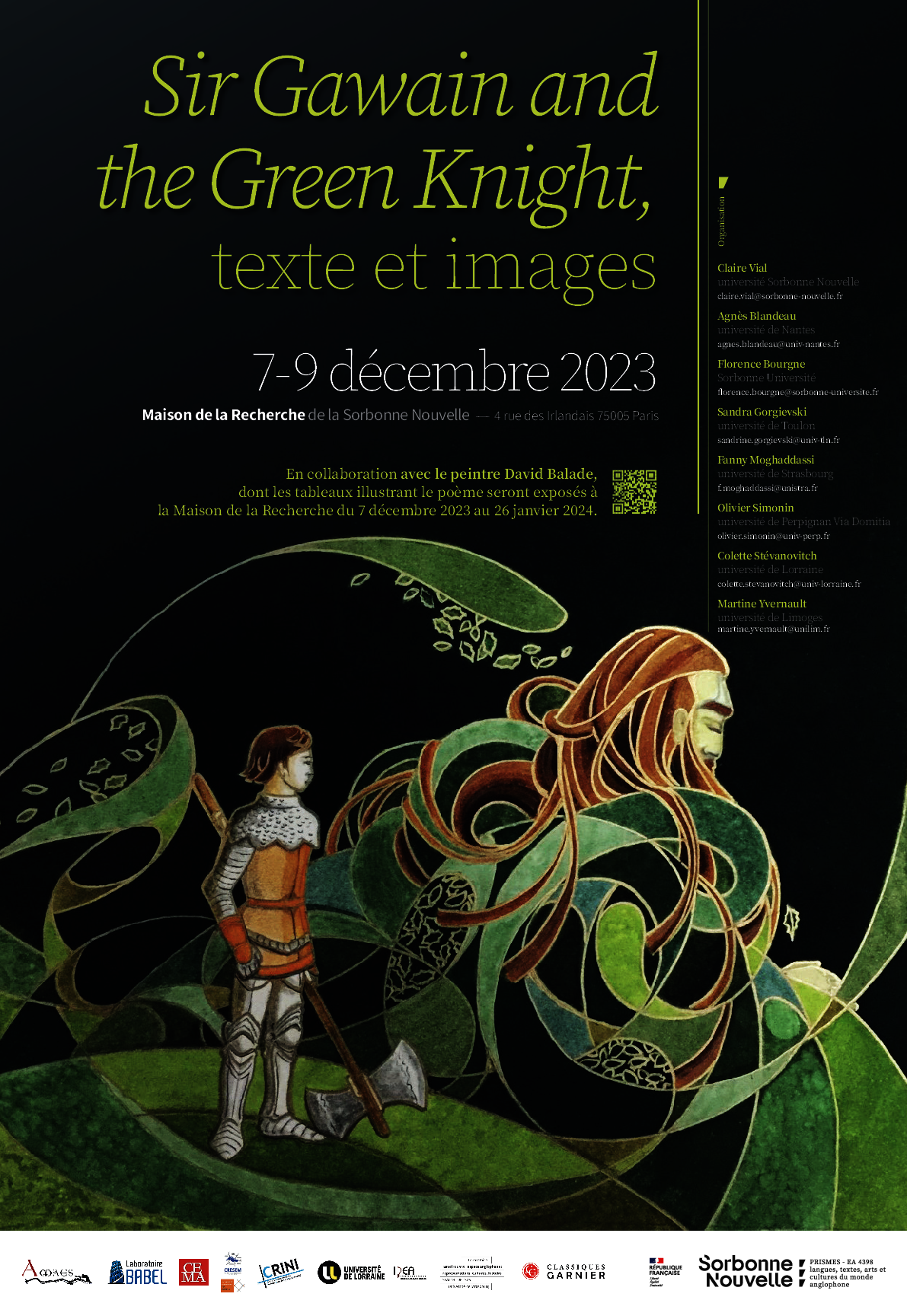Colloque international Sir Gawain and the Green Knight : texte et images
Dates : 7-9 décembre 2023
Lieu : Maison de la recherche de la Sorbonne Nouvelle, 4 rue des Irlandais, Paris
Programme : à télécharger ici
Conférences plénières / Invité.e.s d’honneur :
- Pr. Ad Putter (Bristol University)
- Pr Kevin J. Harty (La Salle University, Philadelphia)
Sir Gawain and the Green Knight est une oeuvre médiévale d’une grande richesse, œuvre divertissante, source d’apprentissage et d’initiation, intrigante et vibrante, foisonnante d’images et représentations visuelles et qui n’a pas fini de susciter les interprétations les plus variées. Les passages descriptifs y ont la part belle, sans pour autant couper le récit aventureux ni se présenter comme des morceaux de bravoure conventionnels. L'œuvre a donné lieu à de multiples ‘mises en images’ et ce, dès la composition du manuscrit lui-même (ca 1400), fort de quatre illustrations en pleine page pour ce seul poème, qui mêlent humour et réalisme. Des illustrations figurent également dans nombre d’ouvrages modernes appartenant à la littérature de jeunesse. Le récit en vers a donné lieu à plusieurs adaptations cinématographiques, dont la plus récente est The Green Knight de David Lowery (2021). En France, le peintre David Balade lui a consacré une série de tableaux fondés sur le thème de la végétalité; de fait, le poème apparaît fondateur pour la démarche éco-critique dans la littérature de langue anglaise. C’est aussi une œuvre magistrale au sein de la tradition allitérative, qui, à la fin du XIVe siècle, n’a jamais entièrement disparu depuis le vieil-anglais. Le questionnement de l’idéal chevaleresque invite à un regard réflexif sur les stéréotypes attachés à la tradition arthurienne.
Le poème et le film font l’objet d’une question au programme de l’agrégation externe d’anglais pour 2024 ; le poème est étudié dans une édition bilingue qui propose la traduction en anglais moderne du poète Simon Armitage, familier aussi bien des œuvres médiévales que de thématiques très contemporaines.
Comité scientifique :
Claire Vial, Université Sorbonne Nouvelle,
Agnès Blandeau, Université de Nantes,
Florence Bourgne, Sorbonne Université,
Sandra Gorgievski, Université de Toulon,
Fanny Moghaddassi, Université de Strasbourg,
Olivier Simonin, Université de Perpignan Via Domitia,
Colette Stévanovitch, université de Lorraine,
Martine Yvernault, Université de Limoges
English version:
Sir Gawain and the Green Knight is an entertaining, intriguing and vibrant work, full of images and visual representations, a source of learning and initiation which continues to give rise to the most varied interpretations. Descriptions are given pride of place, without disrupting the adventurous narrative or presenting themselves as conventional purple patches. The work has been ‘translated into pictures' in many ways, starting with the composition of the manuscript itself (ca 1400), with four full-page illustrations related to the poem, that combine humour and realism. Illustrations also appear in many modern adaptations of the work for children's literature, or in editions meant for an adult readership (e.g. Theodore Silverstein's translation with engravings by Virgil Burnett, 1974). The verse narrative has been adapted into several films, the most recent being David Lowery's The Green Knight (2021). In France, painter David Balade has dedicated a series of paintings to the poem based on the theme of vegetality (https://www.davidbalade.fr/); indeed, Sir Gawain and the Green Knight appears to be a founding work for the eco-critical approach in English-language literature. It is also a masterful work within the alliterative tradition, which had never entirely disappeared since Old English poetry. The questioning of the chivalric ideal invites a reflective look at the stereotypes attached to the Arthurian tradition.
The poem and the film are the subject of a question on the syllabus for the 2024 agrégation externe d'anglais; the poem is studied in a bilingual edition which offers a translation into modern English by poet Simon Armitage, who is as familiar with medieval works as he is with very contemporary themes.
